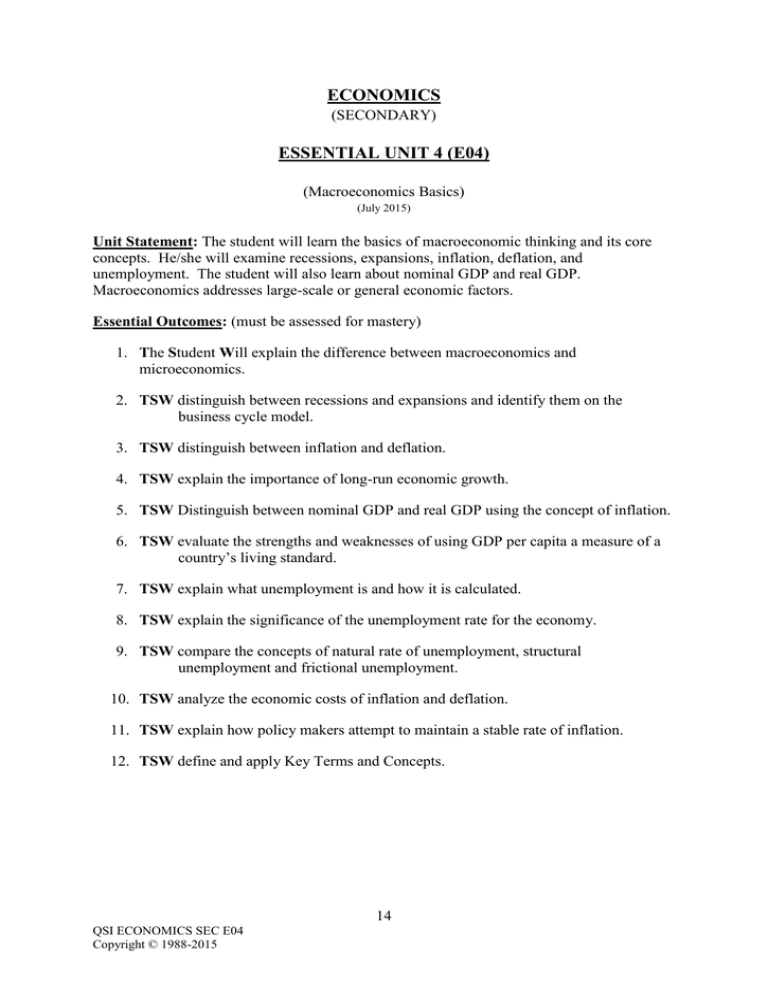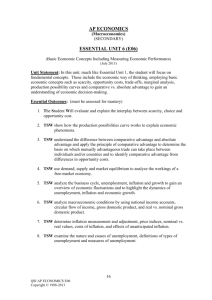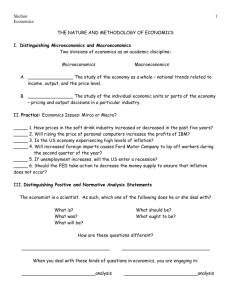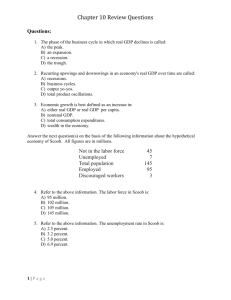ECONOMICS-E04
advertisement

ECONOMICS (SECONDARY) ESSENTIAL UNIT 4 (E04) (Macroeconomics Basics) (July 2015) Unit Statement: The student will learn the basics of macroeconomic thinking and its core concepts. He/she will examine recessions, expansions, inflation, deflation, and unemployment. The student will also learn about nominal GDP and real GDP. Macroeconomics addresses large-scale or general economic factors. Essential Outcomes: (must be assessed for mastery) 1. The Student Will explain the difference between macroeconomics and microeconomics. 2. TSW distinguish between recessions and expansions and identify them on the business cycle model. 3. TSW distinguish between inflation and deflation. 4. TSW explain the importance of long-run economic growth. 5. TSW Distinguish between nominal GDP and real GDP using the concept of inflation. 6. TSW evaluate the strengths and weaknesses of using GDP per capita a measure of a country’s living standard. 7. TSW explain what unemployment is and how it is calculated. 8. TSW explain the significance of the unemployment rate for the economy. 9. TSW compare the concepts of natural rate of unemployment, structural unemployment and frictional unemployment. 10. TSW analyze the economic costs of inflation and deflation. 11. TSW explain how policy makers attempt to maintain a stable rate of inflation. 12. TSW define and apply Key Terms and Concepts. 14 QSI ECONOMICS SEC E04 Copyright © 1988-2015 Key Terms and Concepts: Self-regulating economy Business cycle Price stability Keynesian economics Business-cycle peak Open economy Monetary policy Business-cycle trough Trade deficit Fiscal policy Long-run economic growth Trade surplus Recession Inflation Expansion Deflation Unemployment Natural rate of unemployment Suggested Materials: “Essentials of Economics” Macroeconomics: The Big Picture, GDP and the CPI: Tracking the Macro economy, Unemployment and Inflation Chapters 10, 11, 12; Suggested Strategies: 1. Simulation classroom activity. 2. Teacher generated examinations. 3. “Economics In Action” section from textbook. Technology Tools: WebPath Express (found in school library) Economic education link database: http://www.econedlink.org/web-links/approvedeconomic-web-links.php Foundation for the Teaching of Economics: http://www.fte.org Khan Academy Microeconomics: http://www.khanacademy.org/economics-financedomain/microeconomics Khan Academy Macroeconomics: http://www.khanacademy.org/economics-financedomain/macroeconomics ACDC Econ: https://www.youtube.com/channel/UCCQEbqDL8i40d83Au55lYMQ MJMFoodie Econ: https://www.youtube.com/user/mjmfoodie Jason Welker Econ: https://www.youtube.com/user/welkerjason 15 QSI ECONOMICS SEC E04 Copyright © 1988-2015 QSI ECONOMICS ESSENTIAL UNIT 4 (E04) RUBRIC (Macroeconomics Basics) Must achieve all ‘B’ Level in all TSW’s for a ‘B’. Must achieve 3 of 4 in the ‘A’ column for an ‘A’. The Student Will……. ‘A’ Level Mastery ‘B’ Level Mastery Can explain the difference between macro and microeconomics. 1.explain the difference between macroeconomics and microeconomics. Can diagram the business cycle and explain its features. 2.distinguish between recessions and expansions and identify them on the business cycle model. 3.distinguish between inflation Can explain why inflation and deflation and deflation. can be very challenging for policy makers. Can identify specific benefits of long term growth. 4.explain the importance of long-run economic growth. Can explain how inflation is related to the concept of real GDP. 5.Distinguish between nominal GDP and real GDP using the concept of inflation. 6.evaluate the strengths and weaknesses of using GDP per capita a measure of a country’s living standard. Can describe a more complete picture of development in a country. is and how it is calculated. the unemployment rate for the economy. Can create realistic scenarios in which economic growth is possible despite high unemployment. natural rate of unemployment, structural unemployment and frictional unemployment. Can explain the effects of inflation and deflation on the economy. 10. analyze the economic costs of inflation and deflation. makers attempt to maintain a stable rate of inflation. Can prescribe realistic policies to combat inflation and deflation. Can identify specific actions taken by policy makers to help control and maintain inflation. Can define and apply the key terms. 12. define and apply Key Terms and Concepts. 16 QSI ECONOMICS SEC E04 Copyright © 1988-2015 Can explain how unemployment is related to the economic performance of a country. Can accurately describe all three concepts and distinguish using examples of all each. 9.compare the concepts of 11. explain how policy Can identify how real GDP is a limited tool in assessing and comparing different countries. Can explain the concept of unemployment and make basic unemployment calculations based on its definition. 7.explain what unemployment 8.explain the significance of Can explain the causes of inflation and deflation. NOTES








